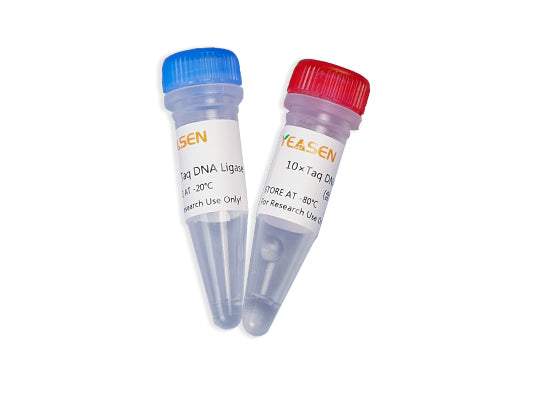คำอธิบาย
Taq DNA Ligase is a thermostable ligase that catalyzes the formation of a phosphodiester bond between the 5'-phosphate and 3'-hydroxyl groups of two adjacent oligonucleotides hybridized to the same complementary target DNA strand. This catalytic reaction occurs only when the two oligonucleotides are perfectly paired with the complementary target DNA and there is no gap between the two oligonucleotides. Therefore, it can be used to detect single-base substitutions. Taq DNA Ligase uses NAD+ as a cofactor and is active in the temperature range of 45°C to 65°C.
Applications
Specific detection of alleles using ligase detection reaction and ligase chain reaction
Mutagenesis by PCR amplification incorporating phosphorylated oligonucleotides
Homologous recombination
Specifications
|
Concentration |
40 U/μL |
|
Source |
Recombinant E. coli strain containing the ligase gene cloned from Thermus aquaticus HB8. |
|
Unit Definition |
One unit of activity is defined as the amount of enzyme required to ligate 50% of 1 µg of λDNA fragments digested with BstEII (12 bp sticky ends) within 15 minutes at 45°C in a 50 µL reaction volume |
|
Inactivation conditions |
Incubate at 45°C for 15 minutes. Add stop dye (50% glycerol, 50 mM EDTA, and bromophenol blue) to terminate the reaction |
Components
|
Components No. |
Name |
11051ES80 |
11051ES84 |
11051ES92 |
|
11051-A |
Taq DNA Ligase (40 U/µL) |
50 μL |
5×50 μL |
|
|
11051-B |
10×Taq DNA Ligase Buffer(NAD+) |
250 μL |
500 μL |
5×500 μL |
Shipping and Storage
This product should be stored at -25 ~ -15℃ for 1 year.
Documents:
Safety Data Sheet
Manuals
การชำระเงินและความปลอดภัย
ข้อมูลการชำระเงินของคุณได้รับการดำเนินการอย่างปลอดภัย เราไม่เก็บรายละเอียดบัตรเครดิตและไม่สามารถเข้าถึงข้อมูลบัตรเครดิตของคุณได้
การสอบถาม
คุณอาจชอบ
คำถามที่พบบ่อย
ผลิตภัณฑ์นี้มีวัตถุประสงค์เพื่อการวิจัยเท่านั้น และไม่ได้มีวัตถุประสงค์เพื่อใช้ในการรักษาหรือวินิจฉัยโรคในมนุษย์หรือสัตว์ ผลิตภัณฑ์และเนื้อหาได้รับการคุ้มครองโดยสิทธิบัตร เครื่องหมายการค้า และลิขสิทธิ์ที่เป็นของ
แอปพลิเคชั่นบางตัวอาจต้องใช้สิทธิ์ในทรัพย์สินทางปัญญาของบุคคลที่สามเพิ่มเติม

